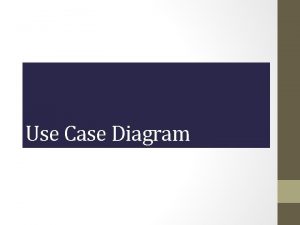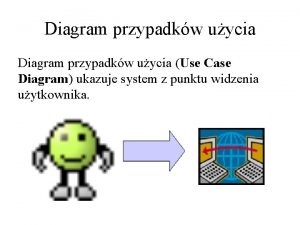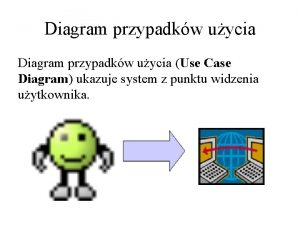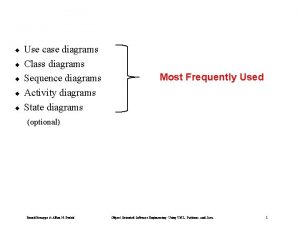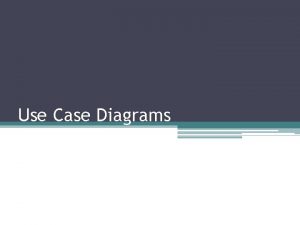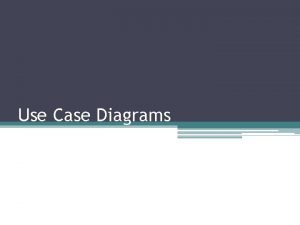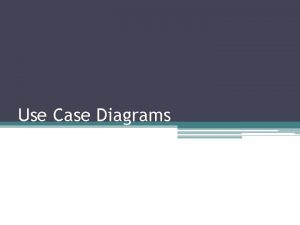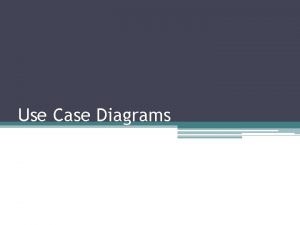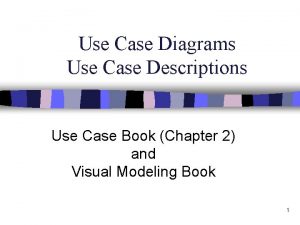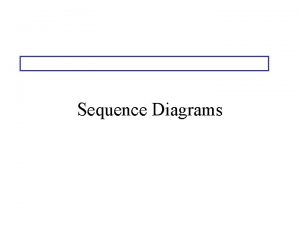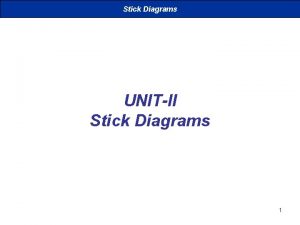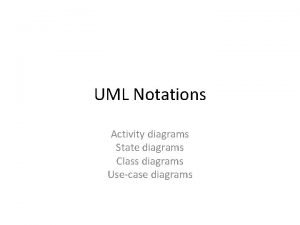Use Case Diagrams Use Case Diagrams Use Case













- Slides: 13

Use Case Diagrams • • • Use Case Diagrams Use Case Actor Use case description Use case realization (Scenario) Use case relationships – Extends – Uses

Use Case Diagrams · shows the relationship among actors and use cases within a system. · the use case model represents functionality of a system or a class as mainfested to external interactors with the system · shows a system boundary Example

Use Case Model

Use Case · a sequence of transactions in a system whose task is to yield a measurable value to an individual actor of the system · UML definition : a coherent unit of functionality provided by a system as sequences of messages among the system and one or more outside interactors (called actors) together with actions performed by the system · the set of all use cases describes the whole functionality of the system · represents WHAT the system must provide, NOT HOW

Actor · a ROLE of object or objects OUTSIDE of a system that interacts directly with it as part of a use case · one physical object may play several roles (modeled by several actors) · types of actors · a primary actor initiates a use case · secondary actors (usualy machines) are called by the system to compleete a use case · actor inheritence · the specialized actor gets all capabilities of the parent actor

Example (of actors and use cases)

• Goal – should be a central notion during the use case analysis – most people (even the non-technical ones) usualy think in goals while making their jobs – main objective of a software systems is to provide “some assitance” on the users’ jobs – speak with their own language, the language of • GOALS and RESPONSIBILITIES.

• Use case description · Name · Goal · Preconditions · Postconditions (success and failed) · Normal flow of events (main scenario) · Alternative flows of events (alternative scenarios) · Additional properties · priority, schedule, time, frequency · other non-functional requirements · Open issues

Use case realization (Scenario) · an instance of a use case (with real data values) · potentialy hundreds to thousends in an application · use cases represents a set of potential scenarios · interaction diagrams describe how use cases are realized as interactions among societes of objects Use case relationships · Communicates · the participation of an actor in a use case · the only relationship between actors and use cases · Extends & Uses · are means for structuring and simplifying functional requirements

Use case relationships - Extends · indicates that the instance of extended (base) use case MAY include the behaviour specified by the extending use case · a single use case may have several extenders · extension often represents unusual behaviour (esception, error) · an extension point is a location within a use case at which action sequences from other use cases may be inserted. · the base use case may be unaware of the extension

Example (of extends relationship)

Use case relationships - Uses · indicates that an instance of the use case will also include the behaviour as specified by the included use case(s) Example

• Process of use case modelling · capture common vocabulary (glossary) · find actors (diferentiate primary and secondary actors) · for each actor determine a set of its of use cases · briefly describe use cases and actors · package use cases and actors · structure the use case model · prioritize use cases · describe use cases
 The interaction diagrams, use case diagrams are called as
The interaction diagrams, use case diagrams are called as An activity diagram is a static model.
An activity diagram is a static model. Include extend use case
Include extend use case Why are use case diagrams important
Why are use case diagrams important Best worst and average case
Best worst and average case Diagram przypadków użycia include extend
Diagram przypadków użycia include extend Case diagrams
Case diagrams Hcf with venn diagrams
Hcf with venn diagrams Difference between short case and long case
Difference between short case and long case Average complexity of binary search
Average complexity of binary search Case western reserve university case school of engineering
Case western reserve university case school of engineering Bubble sort best case and worst case
Bubble sort best case and worst case Fbi virtual case file case study
Fbi virtual case file case study Bubble sort best case and worst case
Bubble sort best case and worst case


